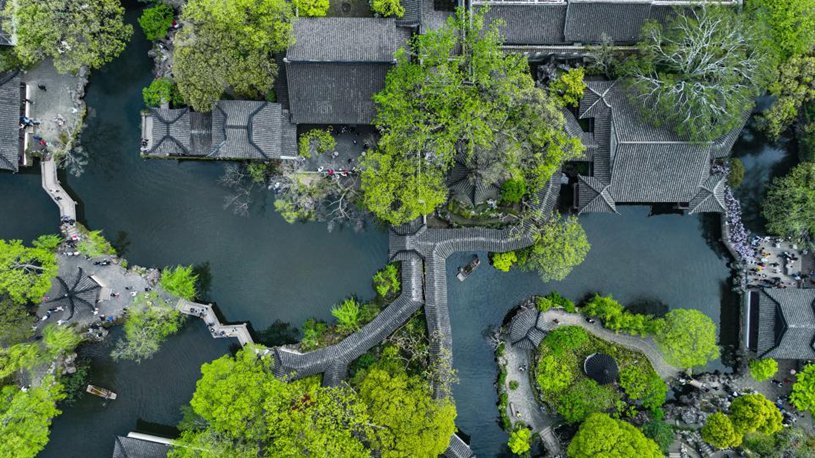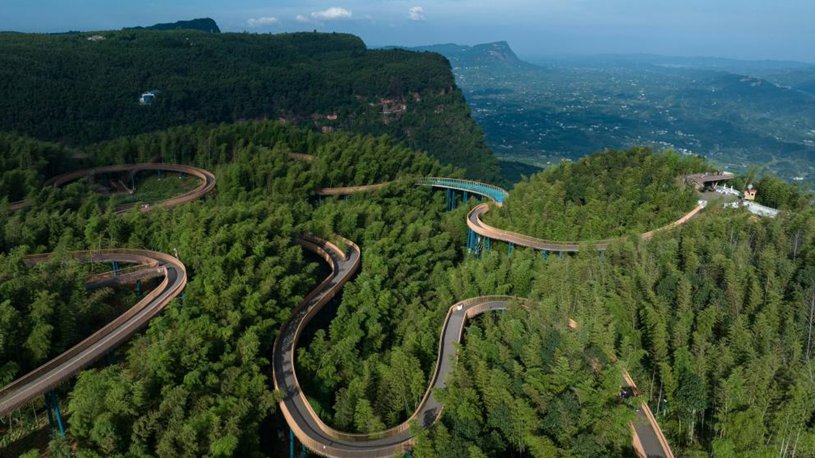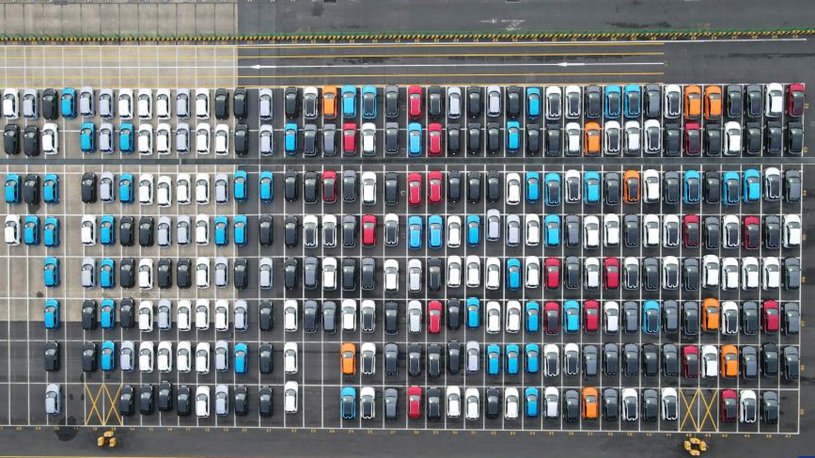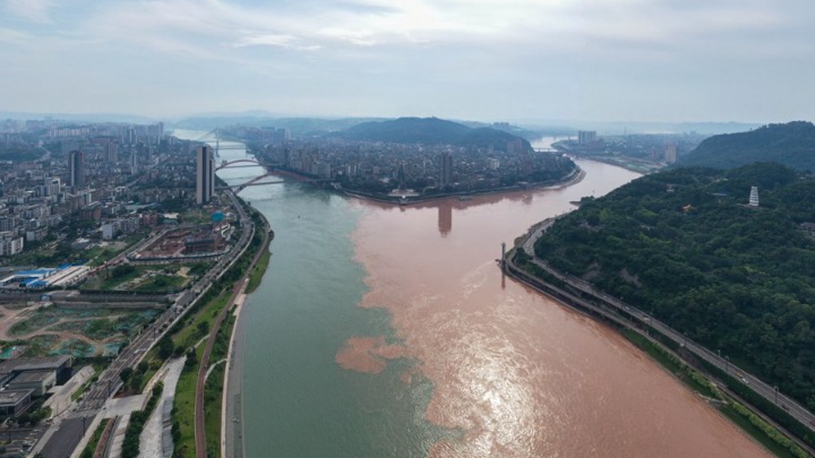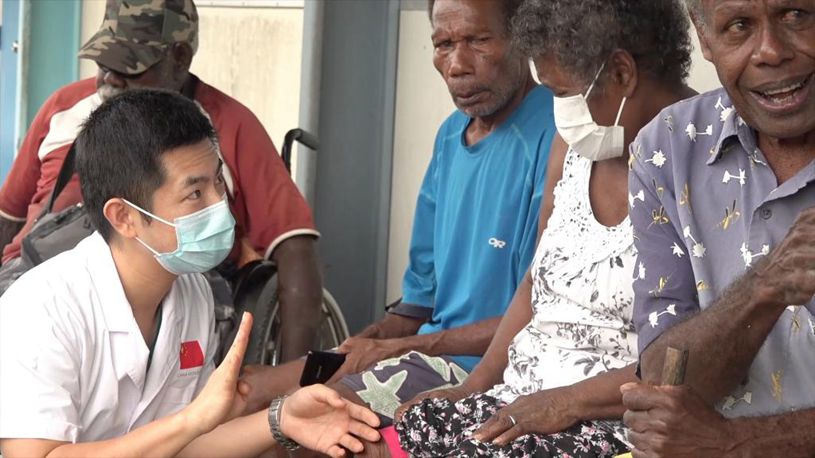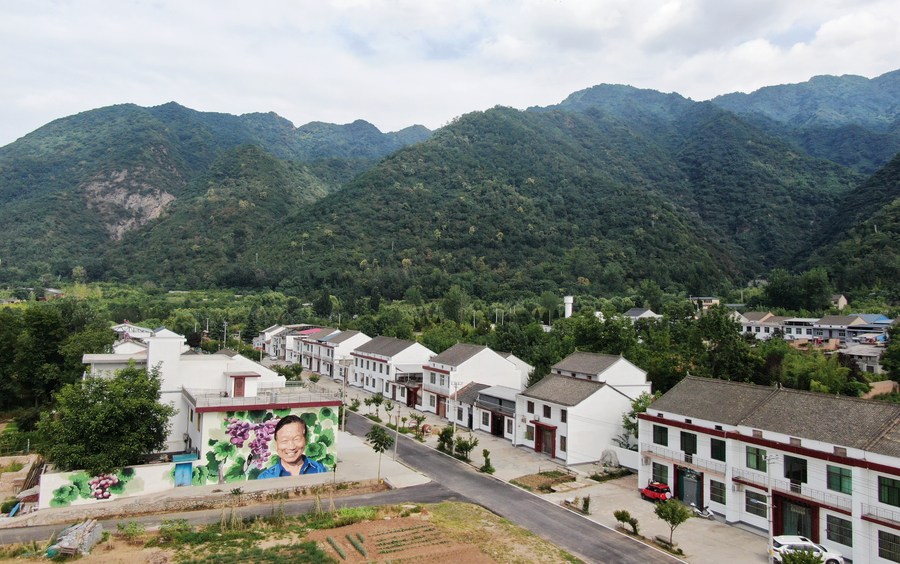
Aerial photo taken on July 5, 2022 shows a view of Caijiapo Village, Huyi District of Xi'an, northwest China's Shaanxi Province. (Xinhua/Li Yibo)
XI'AN, July 13 (Xinhua) -- Strolling through her home village of Caijiapo just recently, Yu Xiaoqin stumbled across a photo exhibition. It was a pleasant surprise for the 72-year-old farmer, who had never encountered such a show before.
The theme of the photos was the folk arts of northwest China's Shaanxi Province and east China's coastal province of Fujian, including the Qinqiang Opera and the traditional waist drums, both of which Yu was familiar with. There are also pictures of the Gaojia Opera and the Hakka earth buildings, which were a novelty to her.
Nestling in the Qinling Mountains, about 50 km from Xi'an, capital of Shaanxi, Caijiapo was once typical of villages in this remote rural area. However, in recent years, it has received an infusion of artistic activity that has transformed the lives of residents.
The village is the venue for the Guanzhong Mangba Arts Festival, the fifth edition of which started on Saturday. The months-long event sees Caijiapo come to life during summer with a range of artistic activities, including a theater festival and exhibitions on themes related to rural life. It is named after the "Mangba" season, which is the period of rest after the summer harvest has been gathered in.
"When I was a child, my family was so poor that I didn't go to school for a single day," said Yu.
Recalling life in Caijiapo more than two decades ago, she said the villagers lived a tough and basic existence. They walked on dirt roads, slept on heated earthen beds, and fired up clay ovens for cooking and heating. They worked hard to make ends meet, and had no time to appreciate the arts.
However, since the Mangba festival was first launched in 2018, it has transformed Caijiapo, bringing a range of artistic experiences to the local residents, while boosting the local economy through cultural tourism. Visitors enjoy symphonies in wheat fields and attend art exhibitions, taking selfies and spreading the word through social media. They are joined by the many villagers who have embraced the arts, some of whom have become artists in their own right.
ART ON THE DOORSTEP
Walking through Caijiapo, Yu can also enjoy dozens of wall paintings, each measuring over 100 square meters and featuring various artistic styles, including surrealism. In the paintings she can see traces of Vincent van Gogh and Pablo Picasso, as well as flowers and farmers.
The wheat fields around the village are also dotted with modern artworks, including a tree-shaped windmill titled "Flourishing Flowers" and a graffiti work called "Lost Tower."
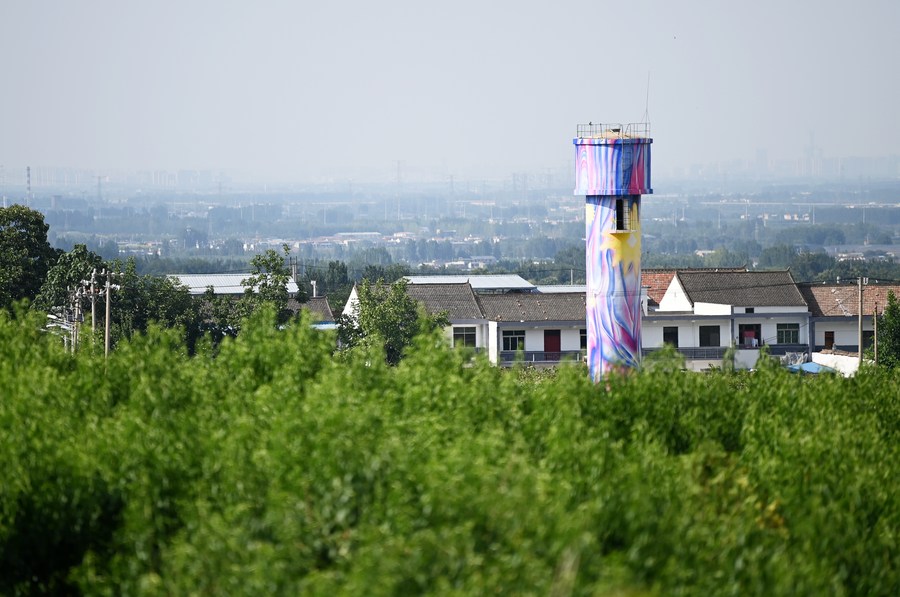
Photo taken on July 5, 2022 shows a manually decorated water tower in Caijiapo Village, Huyi District of Xi'an, northwest China's Shaanxi Province. (Xinhua/Li Yibo)
The history museum, meanwhile, provides a good source of nostalgia, featuring photographs recording the lives of the villagers. And in the village art museum, there are artworks fashioned from peeled corn cobs and sickles normally used to bring in the wheat harvest.
Yu said her favorite place to go in Caijiapo is the open-air Zhongnan Theater, a semicircular stepped facility that was previously a brick kiln. Over the past five years, she has also spent many happy hours watching avant-garde dramas and listening to jazz music and symphony concerts, all for the first time.
"I have liked the arts since I was a child, but I only used to watch Qinqiang Opera and yangko (a folk-style Chinese dance). Now the village often holds various art performances, and I don't miss any of them," she said.
This year, Yu got up on stage and sang a song of her own composition to the rhythm of the Kuaiban, a bamboo instrument. The lyrics expressed her gratitude to those who brought this burst of creativity to the village: "Art academy teachers and students come year by year, each farmer smiles with joy clear; the baton passes fast, no delay, successors ensure the luster will stay."
The teachers and students mentioned in Yu's song are among the chief promoters of Caijiapo's transformation.
ART EXPERIMENT
For villager Chen Meng, the first profound encounter between Caijiapo and the arts was in 2018, when the village held the first Mangba festival.
At that time, artists placed tall flagpoles in the wheat fields, on top of which were huge portraits of the owners of the fields. "It symbolized the relationship between the people and the land, while also paying tribute to the vast number of Chinese farmers," said Chen.
According to Cui Kaimin, a teacher from the Xi'an Academy of Fine Arts, that first festival was the result of a social research project conducted in 2018 by teachers and students from the academy's Experimental Arts Department. During the research, they found that the village was picturesque but had been "hollowed out" by migration. Many people of working age had left in search of work, leaving behind mostly elderly people and children.
"When the young students arrived in the village, many elderly people invited them to their homes for dinner, hoping to chat and encounter something new," Cui recalled.
In conversations with the villagers, the students and teachers spotted a folk custom called the "Mangba meeting," meaning "gathering in the fallow season" in the local dialect. Traditionally, after the annual wheat harvest, farmers on the Guanzhong Plain would enjoy a period of leisure, visiting relatives and friends to share steamed buns and fruit, together with their farming experience.
"Experimental art advocates having a relationship with society and participating in livelihood practices. We decided to use the Mangba meeting to conduct an art experiment in Caijiapo," said Cui.
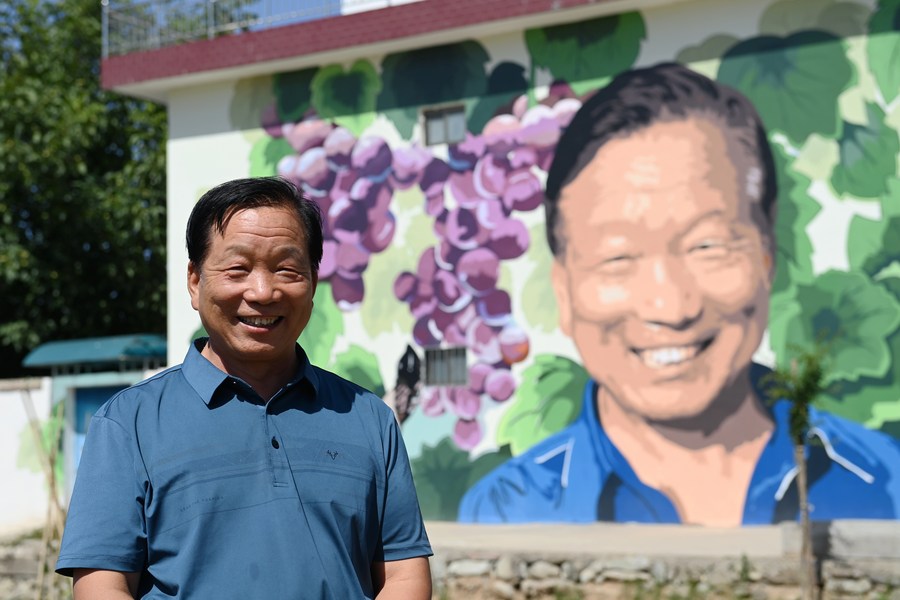
Villager Wang Yan poses for a photo in front of his portrait on the wall in Caijiapo Village, Huyi District of Xi'an, northwest China's Shaanxi Province, on July 6, 2022. (Xinhua/Li Yibo)
During the festival's first edition, various activities were held in the wheat fields, including short sketches by the villagers and avant-garde dramas. The teachers and students also crafted artworks from wheat straw and tree branches, turning the village and fields into art spaces. The event struck a positive chord.
In 2019, local cadres asked the artists a question: "Can this festival be repeated?"
They had every reason to want it to continue in future years, as the first edition had attracted a large number of tourists, providing a new market for the village's agricultural products.
Based on this early success, the village, with a population of nearly 4,000, began a process of systematically transforming itself into a venue for the arts, developing the range of creative events on offer, along with services and facilities for visitors.
Over the years, each edition of the festival has become more diverse, while the facilities and infrastructure have been greatly improved, thanks to the concerted efforts of local authorities and the academy. The facilities now include artistic souvenirs, homestays, cafes and restaurants, all of which bring in revenue.
Qin Weidong, Party chief of Caijiapo Village, said more than 200 villagers now work in the tourism sector, and the total annual tourism revenue has exceeded 14 million yuan (about 1.96 million U.S. dollars). During this year's Dragon Boat Festival holiday, which lasted from June 22 to 24, Caijiapo received more than 50,000 tourist visits.
LIVES TRANSFORMED
Since 2018, the villagers have not only lived a better life, but have become more involved in creative endeavors. They have gone from knowing practically nothing about art to seeing art integrated into their daily lives, to the extent that the wheat harvest itself has become part of a broader creative endeavor.
Some villagers have even become artists in their own right. Han Yangquan, a villager from Caijiapo, had learned to use cameras and take pictures, putting on a photo exhibition outside his home. "You can discover the beauty of life in this way, and learn to express a certain emotion in your heart," said Han.
Liu Xinyuan, another villager, likes planting flowers and plants. During the ongoing festival, together with the academy's teachers, students and tourists, she built a "symbiotic botanical garden" in front of her house, with the old items she collected from other villagers.
"Previously, I thought that only flowerpots could be used to grow flowers, but in the eyes of the artists, old benches and even saddles can be used for that purpose," said Liu. "Art hasn't just turned Caijiapo into a destination for social-media celebrities. More importantly, it constantly impacts and subverts our original notions."
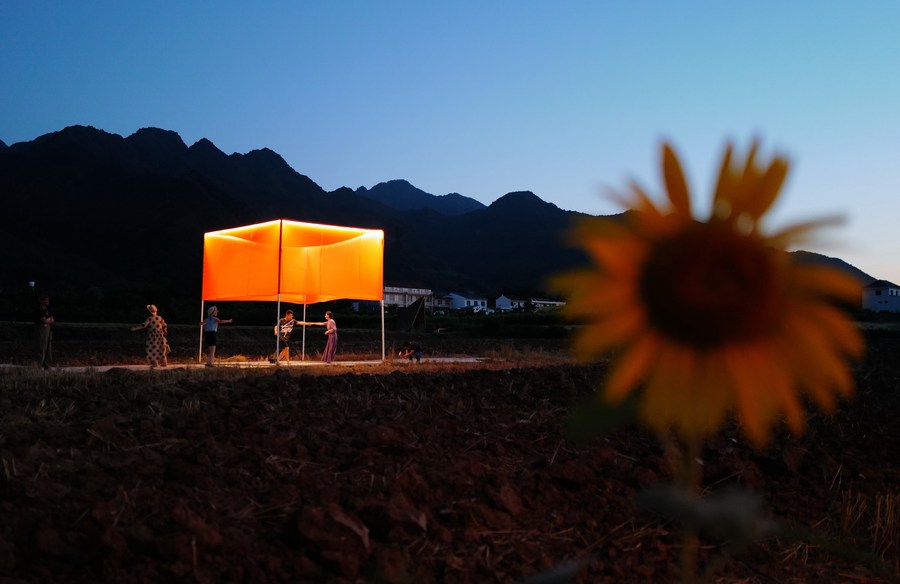
Tourists dance in an already harvested wheat field in Caijiapo Village, Huyi District of Xi'an, northwest China's Shaanxi Province, on June 12, 2022. (Xinhua)
By embracing the arts, Caijiapo has undergone a profound transformation, both economically and socially. But those changes have also injected new vitality into the surrounding villages. Inspired by Caijiapo's example, they have launched tourist-friendly projects of their own.
Xiazhuang Village, for example, has built a demonstration village for the inheritance of new folk art. Liyukou Village, meanwhile, has built a "reception hall" to create a cultural industry cluster of rural makers. All of these efforts have attracted visitors and boosted business activity.
Song Naihong, 45, a villager from Liyukou, used to run a noodle restaurant. In 2022, when the Liyukou-based Two Tree Coffee began recruiting, Song signed up and learned to use computers and make coffee.
Today, she is a coffee making master proficient in latte art. "As the job requires me to keep learning and encountering new things, I feel that my life is really fulfilling," said Song. ■

